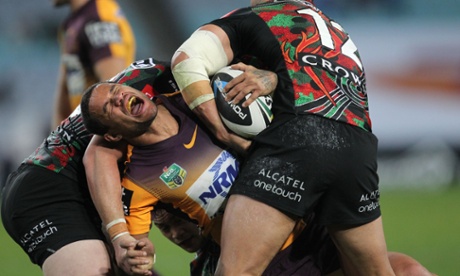The findings of a new report on sporting injuries are both surprising (who would have thought golf is a hidden killer?) and expected (stay away from quadbikes), but how do the major codes stack up?

More people are taken to hospital for injuries sustained playing Australian rules and soccer than other sports, but soccer still remains one of the safer team sports when the participation rate is taken into account.
The Australian Institute of Health and Welfare (AIHW) has issued its latest report on sports injuries requiring hospital treatment. When a patient is admitted to hospital with an injury, information about the activity that caused it is submitted to the national hospital morbidity database. This includes the type of sport, if known, and does not distinguish between amateur and professional sporting activity.
The report found that 61% of injury cases in the database did not include an activity code, so the raw number of incidents per sport is likely to be higher. However, this under-reporting is unlikely to affect the rates.
Here are the results (use the drop-down menu to compare different stats):
So, what is the most dangerous sport? For this you probably want to consider the rate of cases by the number of people participating in the sport, as well as the severity of the injuries involved.
Soccer has by far the highest participation rate out of all the football codes, and if you look at the rate of injury by participation in the graph above, soccer is far lower than Aussie rules and all types of rugby.
Wheeled motor sports (eg quadbikes, motorcycles, go-karts) have the highest injury rate by participation, followed by roller sports (eg roller skating, skateboarding, scooters). Of regular team sports, Australian rules and all types of rugby are the highest, indicating participants in these sports are more likely to be taken to hospital with an injury than those in other team sports. Netball and cricket are probably the safest.
The research measured the percentage of injuries that represented a “high threat to life”, which in this case counts injuries that have a predicted mortality risk of 6% or higher. Not surprisingly, wheeled motor sports also rank highly for severity of injuries, second to roller sports in the high threat to life category.
Golf is surprisingly high on the list for a non-contact sport for both high threat to life and the mean number of days in hospital resulting from the injury. Looking at the age distribution of injury rates, this is probably due to the greater proportion of older people taking part in golf (compare the age distribution to other sports using the drop-down):
Falls were the most common cause of injury in golf:
The other interesting bit of information from the report is the rate of injury by remoteness. Since the Australian Bureau of Statistics doesn’t break down sporting participation by location, we can’t tell the comparative popularity of different sports in urban and regional areas.
But if we use the injury figures as a proxy for participation, we can see some interesting trends. Soccer seems to be more popular in big cities and and inner regional areas, whereas Australian rules and the rugby codes are more popular in remote and regional areas.
